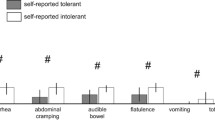Abstract
Lactase deficiency has a high prevalence worldwide. Thus, a valid symptom scale would be a useful tool for identifying patients with lactose malabsorption. Objective To develop, validate, and apply a symptoms questionnaire on lactose malabsorption to identify lactose malabsorbers diagnosed with the gold-standard hydrogen breath test. Methods In the first part of the study, 292 patients completed a questionnaire at the end of a 50-g lactose breath test. The questionnaire included five items (diarrhea, abdominal cramping, vomiting, audible bowel sounds, and flatulence or gas) scored on a 10-cm visual analogue scale. In the second part of the study, 171 patients completed the questionnaire twice: first, according to their opinion when consuming dairy products at home and second, after a 50-g lactose breath test. Patients were grouped as absorbers or malabsorbers according to the result of the breath test. Results Diarrhea, abdominal cramping, and flatulence were scored significantly higher in malabsorbers than in absorbers. Total score of the symptomatic questionnaire was significantly higher in malabsorbers (17.5 versus 3.0, P < 0.01). According to receiver operator characteristics (ROC) analysis, the most discriminant cut-off of the total score to identify lactose malabsorption was 6.5 (sensitivity 0.75, specificity 0.67). In 58 malabsorbers the effect size of the questionnaire to determine sensitivity to change was 1.32. In the second part of the study, scoring of the home questionnaire was higher than after the lactose-breath test. The lactose malabsorbers rate was higher according to the home questionnaire than after the lactose breath test (72% versus 52%). The home questionnaire had excellent sensitivity (0.82) but low specificity (0.35). Conclusion We developed and validated a five-item symptoms questionnaire for lactose malabsorption. This is a valid test that permits patients with a total score lower than 7 to be excluded from future studies.






Similar content being viewed by others
References
Peña A, Peña JF. Malabsorción de lactosa en estudiantes españoles. Tolerancia intestinal a la sobrecarga oral de lactosa. Rev Esp Enferm Dig. 1971;35:925–938.
Carnicer J. Malabsorció de lactosa en una població preescolar i escolar. But Soc Cat Pediatr. 1993;53:26–32.
Vázquez C. Malabsorción de los hidratos de carbono en el niño: malabsorción de la lactosa. Esp Ped. 1975;8:166–178.
Leis R, Tojo R, Pavón P, Douwes A. Prevalence of lactose malabsorption in Galicia. J Ped Nutr. 1997;25:296–300. doi:10.1097/00005176-199709000-00009.
Sahi T. Hypolactasia and lactase persistence. Historical review and terminology. Scand J Gastroenterol. 1994;29(suppl 202):1–6, 994. doi:10.3109/00365529409091739.
Melvin BH and the Committee on Nutrition. Lactose intolerance in infants, children and adolescents. Pediatrics. 2006;118:1279–1286. doi:10.1542/peds.2006-1721.
Bond JH, Levitt MD. Quantitative measurement of lactose absorption. Gastroenterology. 1976;70:1058–1062.
Di Palma JA, Narvaez RM. Prediction of lactose malabsorption in referral patients. Dig Dis Sci. 1988;33:303–307. doi:10.1007/BF01535754.
Suarez FL, Savaiano DA, Levitt MD. A comparison of symptoms after the consumption of milk or lactose-hydrolyzed milk by people with self-reported severe lactose intolerance. N Engl J Med. 1995;333:1–4. doi:10.1056/NEJM199507063330101.
Pelletier X, Laure-Boussuge S, Donazzolo Y. Hydrogen excretion upon ingestion of dairy products in lactose-intolerant male subjects: importance of the live flora. Eur J Clin Nutr. 2001;55:509–512. doi:10.1038/sj.ejcn.1601169.
Vermia P, Di Camillo M, Marinaro V. Lactose malabsorption, irritable bowel syndrome and self-reported milk intolerance. Dig Liver Dis. 2001;33:234–239. doi:10.1016/S1590-8658(01)80713-1.
Vonk RJ, Priebe MG, Koetse HA, et al. Lactose intolerance: analysis of underlying factors. Eur J Clin Invest. 2003;33:70–75. doi:10.1046/j.1365-2362.2003.01099.x.
Pimentel M, Kong Y, Park S. Breath testing to evaluate lactose intolerance in irritable bowel syndrome correlates with lactulose testing and may not reflect true lactose malabsorption. Am J Gastroenterol. 2003;98:2700–2704. doi:10.1111/j.1572-0241.2003.08670.x.
Suarez FL, Savaiano DA. Lactose digestion and tolerance in adult and elderly Asian-Americans. Am J Clin Nutr. 1994;59:1021–1024.
Hermans MM, Brummer RJ, Ruijgers AM, Stocbrügger RW. The relationship between lactose tolerance test results and symptoms of lactose intolerance. Am J Gastroenterol. 1997;92:981–984.
Peuhkuri K, Vapaatalo H, Nevala R, Korpela R. Temperature of a test solution influences abdominal symptoms in lactose tolerance tests. Scand J Clin Lab Invest. 2000;60:75–80. doi:10.1080/00365510050185065.
Casellas F, Malagelada JR. Applicability of short hydrogen breath test for screening of lactose malabsorption. Dig Dis Sci. 2003;48:1333–1338. doi:10.1023/A:1024163327183.
Casado A, Prieto L, Alonso J. El tamaño del efecto de la diferencia entre dos medias: ¿estadísticamente significativo o clínicamente relevante? Med Clin (Barc). 1999;112:584–588.
Bullinger M, Anderson R, Cella D, Aaronson N. Developing and evaluating cross-cultural instruments from minimum requirements to optimal models. Qual Life Res. 1994;2:451–459. doi:10.1007/BF00422219.
Iqbal TH, Bradley R, Reilly KO, Cooper BT. Small intestinal lactase status, frequency distribution of enzyme activity and milk intake in a multi-ethnic population. Clin Nutr. 1996;15:297–302. doi:10.1016/S0261-5614(96)80003-3.
Gupta SK, Chong SKF, Fitzgerald JF. Disaccharidase activities in children: normal values and comparison based on symptoms and histologic changes. J Pediatr Gastroenterol Nutr. 1999;28:246–251. doi:10.1097/00005176-199903000-00007.
Leis R, Tojo R, Pavón P, Douwes A. Prevalence of lactose malabsorption in Galicia. J Pediatr Gastroenterol Nutr. 1997;25:296–300. doi:10.1097/00005176-199709000-00009.
Vernia P, Camillo M, Marinaro V, Caprilli R. Lactose malabsorption and the genesis of irritable bowel syndrome symptoms. Gastroenterology. 2001;120(Suppl 1):A264.
Martini MC, Savaiano DA. Reduced intolerance symptoms from lactose consumed during a meal. Am J Clin Nutr. 1988;47:57–60.
He T, Priebe MG, Harmsen HJ, et al. Colonic fermentation may play a role in lactose intolerance in humans. J Nutr. 2006;136:58–63.
Acknowledgments
We thank Miss. Christine O’Hara for valuable contributions to the English revision of this manuscript. Ciberehd is funded by the Instituto de Salud Carlos III, Spain. This work was supported in part by grants from the Generalitat de Catalunya (RE: 2001SGR00389) and Centro de Investigación Biomédica en Red de Enfermedades Hepáticas y Digestivas (Ciberehd, Spain).
Author information
Authors and Affiliations
Corresponding author
Rights and permissions
About this article
Cite this article
Casellas, F., Varela, E., Aparici, A. et al. Development, Validation, and Applicability of a Symptoms Questionnaire for Lactose Malabsorption Screening. Dig Dis Sci 54, 1059–1065 (2009). https://doi.org/10.1007/s10620-008-0443-3
Received:
Accepted:
Published:
Issue Date:
DOI: https://doi.org/10.1007/s10620-008-0443-3




